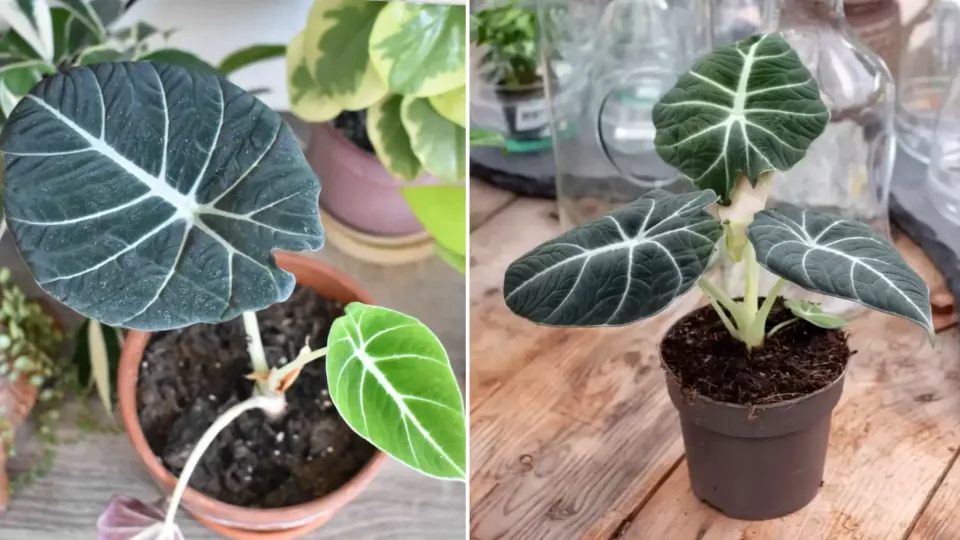In the world of exotic and captivating houseplants, few can match the enchanting allure of the Alocasia Black Velvet, scientifically known as Alocasia Reginula. This botanical gem, often referred to as the “Little Queen,” captivates with its dark, velvety leaves adorned with striking silver veins.

The Alocasia Black Velvet isn’t merely a plant; it’s a work of art that demands a specific kind of care and attention to flourish and thrive within your indoor sanctuary. In this article, we delve into the intricate world of Alocasia Black Velvet care, revealing the secrets to cultivating its dark elegance.
Origin and Overview
Originating from the lush jungle floors of Southeast Asia, particularly Borneo, the Alocasia Black Velvet belongs to the Araceae family of evergreen perennials. The plant’s most distinctive feature is its captivating dark leaves adorned with prominent pale green, white, or silver veins, creating a mesmerizing contrast that draws the eye.
The leaves of the Alocasia Black Velvet are heart-shaped and possess a velvety texture, almost reminiscent of succulents. These leaves, measuring about six inches in length and two-and-a-half inches in width, have evolved as an ingenious light-gathering strategy.
Cultivation and Care
The Alocasia Black Velvet, while not overly demanding, requires a thoughtful approach to care that caters to its specific preferences. Understanding its key requirements is essential for fostering its growth and vitality.
- Light Requirements: While the Alocasia Black Velvet doesn’t crave intense light, it certainly thrives in medium to bright indirect light. Placing it too close to a strong light source can lead to scorched leaves, so finding the right balance is crucial.
- Watering: Watering is a critical aspect of care for the Alocasia Black Velvet. To avoid root rot, allow the top two inches of soil to dry before watering. The plant prefers higher humidity levels but despises soggy soil conditions. When watering, thoroughly wet the soil and allow excess water to drain through the drainage holes in the container.
- Soil: Creating the perfect soil mix is integral to the plant’s well-being. The ideal mix should be coarse and well-draining, providing ample aeration to the roots. A combination of materials like perlite, orchid bark, sphagnum moss, and coconut coir can create a suitable substrate.
- Temperature and Humidity: The Alocasia Black Velvet revels in warmth and humidity. It flourishes at temperatures ranging from 59°F (15°C) to 80°F (27°C) or higher. It’s crucial to maintain humidity levels between 60% to 75% to ensure its foliage remains vibrant and free from problems.
- Fertilization: While the Alocasia Black Velvet benefits from monthly fertilization during the growing season, it’s essential to avoid over-fertilization. Using a balanced fertilizer at half or even a quarter of the recommended strength can provide the necessary nutrients without overwhelming the plant.
- Repotting: This plant prefers slightly root-bound conditions, so repotting should be approached cautiously. Repotting every 2-3 years and only increasing the pot size slightly is recommended to prevent overpotting.
- Propagation: Propagating the Alocasia Black Velvet can be achieved through offsets, division of the rhizome, or seeds. Offsets are the easiest method, as they can be planted directly in a suitable mix and provided with consistent care.
Despite its compact stature, rarely exceeding eighteen inches in both height and width, the Alocasia Black Velvet commands attention wherever it resides. The plant exhibits a rhizomatous growth pattern and can remain active year-round with appropriate levels of light and warmth. Its affinity for humidity makes it an ideal candidate for terrarium cultivation, ensuring that its unique beauty doesn’t get overshadowed by its surroundings.
Potential Issues and Solutions
The Alocasia Black Velvet, while captivating, can encounter a range of issues that demand attention. Yellow spots, brown leaf edges, and drooping leaves may signal watering problems, humidity imbalances, or inadequate care. It’s essential to address these concerns promptly to prevent further damage.
Conclusion
The Alocasia Black Velvet, with its captivating dark foliage and elegant silver veins, is a testament to the beauty and intricacies of nature’s design. While its care demands attention to specific details, the reward of nurturing this plant to its full potential is well worth the effort. By understanding its unique requirements for light, watering, soil, temperature, and humidity, you can create an optimal environment that allows the Alocasia Black Velvet to thrive and bring its captivating dark elegance into your living space. Whether it graces your home as a centerpiece or finds a home within a terrarium, the Alocasia Black Velvet’s presence is bound to enchant and delight all who have the privilege of witnessing its allure.
FAQs
Q1. How often should I water my Alocasia Black Velvet?
Proper watering is crucial for the health of your Alocasia Black Velvet. Allow the top two inches of soil to dry out before watering. It’s essential to strike a balance between keeping the soil moist and preventing it from becoming waterlogged. Overly soggy conditions can lead to root rot while letting the soil dry out completely can stress the plant.
Q2. Can I grow Alocasia Black Velvet in low light conditions?
While Alocasia Black Velvet prefers medium to bright indirect light, it can tolerate lower light conditions better than some other aroid species. However, placing it in dim corners for extended periods can result in leggy growth and diminished foliage color. Aim to provide as much indirect light as possible to ensure the plant’s vibrancy and overall well-being.
Q3. Is misting necessary for Alocasia Black Velvet’s humidity requirements?
Misting can help boost humidity levels around your Alocasia Black Velvet, but it might not be sufficient on its own, especially in drier climates. To maintain the recommended humidity range of 60-75%, consider using a room humidifier, grouping plants together, or placing a water tray near the plant. This will help create a more consistent and suitable humidity environment for your Alocasia Black Velvet.
